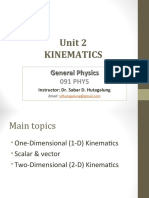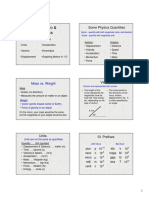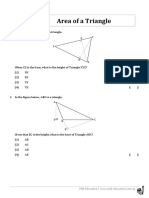0 ratings0% found this document useful (0 votes)
58 viewsKinematics Vocabulary: Units and Vectors and Scalars!
Kinematics Vocabulary: Units and Vectors and Scalars!
Uploaded by
Jeffrey PiggottThis document defines and explains common terms used in kinematics including units of measurement, formulas, and relationships between terms. It covers scalar and vector quantities like time, position, displacement, distance, speed, velocity, acceleration. Graphs of position vs time and velocity vs time are also discussed as tools to determine values, trends and slopes related to motion. Key terms are defined in terms of the units of measurement, relevant formulas, physical meanings, and notes about constant vs changing values.
Copyright:
© All Rights Reserved
Available Formats
Download as PPTX, PDF, TXT or read online from Scribd
Kinematics Vocabulary: Units and Vectors and Scalars!
Kinematics Vocabulary: Units and Vectors and Scalars!
Uploaded by
Jeffrey Piggott0 ratings0% found this document useful (0 votes)
58 views17 pagesThis document defines and explains common terms used in kinematics including units of measurement, formulas, and relationships between terms. It covers scalar and vector quantities like time, position, displacement, distance, speed, velocity, acceleration. Graphs of position vs time and velocity vs time are also discussed as tools to determine values, trends and slopes related to motion. Key terms are defined in terms of the units of measurement, relevant formulas, physical meanings, and notes about constant vs changing values.
Original Title
Kinematics Vocabulary
Copyright
© © All Rights Reserved
Available Formats
PPTX, PDF, TXT or read online from Scribd
Share this document
Did you find this document useful?
Is this content inappropriate?
This document defines and explains common terms used in kinematics including units of measurement, formulas, and relationships between terms. It covers scalar and vector quantities like time, position, displacement, distance, speed, velocity, acceleration. Graphs of position vs time and velocity vs time are also discussed as tools to determine values, trends and slopes related to motion. Key terms are defined in terms of the units of measurement, relevant formulas, physical meanings, and notes about constant vs changing values.
Copyright:
© All Rights Reserved
Available Formats
Download as PPTX, PDF, TXT or read online from Scribd
Download as pptx, pdf, or txt
0 ratings0% found this document useful (0 votes)
58 views17 pagesKinematics Vocabulary: Units and Vectors and Scalars!
Kinematics Vocabulary: Units and Vectors and Scalars!
Uploaded by
Jeffrey PiggottThis document defines and explains common terms used in kinematics including units of measurement, formulas, and relationships between terms. It covers scalar and vector quantities like time, position, displacement, distance, speed, velocity, acceleration. Graphs of position vs time and velocity vs time are also discussed as tools to determine values, trends and slopes related to motion. Key terms are defined in terms of the units of measurement, relevant formulas, physical meanings, and notes about constant vs changing values.
Copyright:
© All Rights Reserved
Available Formats
Download as PPTX, PDF, TXT or read online from Scribd
Download as pptx, pdf, or txt
You are on page 1of 17
Kinematics Vocabulary
Units and vectors and scalars!
t: time
• s (second)
• scalar
• No formula (fundamental measurement)
• When?
• One clock reading
x: position
• m (metre)
• vector
• No formula
• Where?
• Location relative to origin – or ZERO position
Dt: duration
• s (second)
• scalar
• Dt = tf - ti
• How long?
• Change of time, elapsed time, period of time
Dx: displacement
• m (metre)
• vector
• Dx = xf - xi
• How far and which way from start position?
• Change of position
d: distance
• m (metre)
• scalar
• d = total length of path
• How far?
• Total size of path traveled
Savg: Average Speed
• m/s (metre per second)
• scalar
• Savg= d / D t
• How fast?
• Average rate of distance traveled
vavg Average Velocity
• m/s (metres per second)
• vector
• vav= Dx / D t
• vav= slope of (secant) line on x vs t graph
• How fast and which way (has the object been
moving)?
• Average rate of change of position
v: (Instantaneous) Velocity
• m/s (metres per second)
• vector
• v = slope of (tangent) line on x-t graph
• How fast and which way (is/was the object moving at a
certain time)?
• Rate of change of position at a given time
• NOTE: When velocity is constant, the velocity at every
instant is the same as the average velocity for the
interval.
S: (Instantaneous) Speed
• m/s (metres per second)
• scalar
• S= |v|
• How fast?
• Rate of distance traveled at a certain time
• NOTE: When velocity is constant, the speed at
every instant is the same as the average speed for
the interval.
• m/s/s OR m/s2 (metres per second squared)
• vector
• ? = Dv / Dt
• How quickly and which way the velocity
changes?
• Average rate of change of velocity
a: (Average ) Acceleration
• m/s/s OR m/s2 (meters per second squared) {alt.
feet per second squared}
• vector
• aavg= Dv / D t
• How quickly and which way the velocity changes?
• Average rate of change of velocity
• NOTE: We will limit our study of motion to
situations where the acceleration is CONSTANT
Relationships
• Acceleration is to velocity as _____________
is to ________________
• Zero velocity means constant _____________
• Constant velocity means zero _____________
Kinematics Terms and Graphs
Examine, or determine
the values of the Calculate the slope,
Type of Graph coordinates of one or determine any trends
point on the graph… with the slope…
You will know the
position of an object You will know the
position vs time
at a given time; velocity, or know if
knowing this for two the velocity is constant,
points on a graph increasing or decreasing
enables you to compute
slope.
You will know the
velocity of an object at You will know the
velocity vs time a given time; knowing acceleration , or
this for two points on a know if the acceleration
graph enables you to is constant, or not
compute slope.
Kinematics Terms and Graphs
Kinematics Terms and Graphs
Kinematics Terms and Graphs
You might also like
- 100 DerivativesDocument11 pages100 Derivativesemirakkayaa06No ratings yet
- IGCSE Science Homework #1 - Lab Safety: View The Picture Below and Answer The Questions On The Next PageDocument2 pagesIGCSE Science Homework #1 - Lab Safety: View The Picture Below and Answer The Questions On The Next PageJeffrey PiggottNo ratings yet
- Solutions To Physics I C Vector Worksheet IDocument5 pagesSolutions To Physics I C Vector Worksheet IJeffrey PiggottNo ratings yet
- Solutions To Physics I C Vector Worksheet IDocument5 pagesSolutions To Physics I C Vector Worksheet IJeffrey PiggottNo ratings yet
- Dynamics - Absolute MotionDocument9 pagesDynamics - Absolute MotionEuw Chaiwanont100% (1)
- Kinematics Vocabulary: Units and Vectors and Scalars, Oh My!Document17 pagesKinematics Vocabulary: Units and Vectors and Scalars, Oh My!quangNo ratings yet
- HP 02 Motion in One Dimension (This One)Document64 pagesHP 02 Motion in One Dimension (This One)Ramchelle Aive QuintanoNo ratings yet
- Gerak 1 DimensiDocument68 pagesGerak 1 DimensixdcvbjqqdvNo ratings yet
- HP 02 Motion in One DimensionDocument63 pagesHP 02 Motion in One DimensionEng-Mahamed Dayib NourNo ratings yet
- A Level PPT 2Document46 pagesA Level PPT 2YQ TangNo ratings yet
- Gerak 1 DimensiDocument47 pagesGerak 1 DimensiZeroNo ratings yet
- Motion notesDocument2 pagesMotion notesyohio9787No ratings yet
- Unit 2 KinematicsDocument94 pagesUnit 2 KinematicsOsama AbdullahNo ratings yet
- Motion Learn Check 1Document16 pagesMotion Learn Check 1Ricardo BomenyNo ratings yet
- Kinematics NotesDocument16 pagesKinematics NotesCereal KillerNo ratings yet
- Chapter 02Document35 pagesChapter 02Izzah SuhaiziNo ratings yet
- 02 MotionDocument4 pages02 MotionOliveraArsovaNo ratings yet
- Physics Year 10Document27 pagesPhysics Year 10Invalid UserNo ratings yet
- Ch2 Motion in Straight LineDocument56 pagesCh2 Motion in Straight Linecvxg5hk5xxNo ratings yet
- The Branch of Mechanics That Studies The Motion of A Body Without Caring About What Caused The MotionDocument56 pagesThe Branch of Mechanics That Studies The Motion of A Body Without Caring About What Caused The MotionNasir IqbalNo ratings yet
- Physics KinematicsDocument27 pagesPhysics Kinematicssherwinalvin20No ratings yet
- Understanding Distance Time Graph J and Velocity TimeDocument29 pagesUnderstanding Distance Time Graph J and Velocity Timeimran siddiquiNo ratings yet
- Physics Intro & KinematicsDocument7 pagesPhysics Intro & KinematicsEnger AlingasaNo ratings yet
- Chapter 2Document18 pagesChapter 2Taleb AbboudNo ratings yet
- Phys121 L2Document44 pagesPhys121 L2kazazalpNo ratings yet
- IB PHYSICS 2.1 Presentation All UnitDocument52 pagesIB PHYSICS 2.1 Presentation All UnitJustCallMeLarryNo ratings yet
- KinematicsDocument75 pagesKinematicsKunj GuptaNo ratings yet
- Section 2.0 Newtonian MechanicsDocument61 pagesSection 2.0 Newtonian Mechanicsgarikaishumba2005No ratings yet
- Chapter 2 Motion Along A Stright Line (Autosaved)Document190 pagesChapter 2 Motion Along A Stright Line (Autosaved)k7m872q9gbNo ratings yet
- 2 KinematicsDocument17 pages2 KinematicsAmad AliNo ratings yet
- TheoryDocument49 pagesTheoryAman kumarNo ratings yet
- KinematicsDocument96 pagesKinematicsAnkur Jyoti Sarma100% (1)
- PREP CH2 - Motion Lesson SlidesDocument13 pagesPREP CH2 - Motion Lesson SlidesnisaselincamNo ratings yet
- Chapter-2 KinematicsDocument49 pagesChapter-2 KinematicsAgustinus Aldi Irawan RahardjaNo ratings yet
- CHP 2 NotesDocument3 pagesCHP 2 NotesFasihNo ratings yet
- Part 1Document57 pagesPart 1Aelaizza Jane DumdumNo ratings yet
- Motion Physics KinematicsDocument96 pagesMotion Physics KinematicsMadhurima MaityNo ratings yet
- 2 Describing MotionDocument48 pages2 Describing MotionQIONG LIUNo ratings yet
- Section 2.0 Newtonian MechanicsDocument52 pagesSection 2.0 Newtonian MechanicsIm rich lolNo ratings yet
- Kinematics L1Document12 pagesKinematics L1BAISHALI NAGNo ratings yet
- As Level Chapter 2 NotesDocument20 pagesAs Level Chapter 2 NotesVivehaNo ratings yet
- Physics ModuleDocument32 pagesPhysics ModuleDENOMINATOR0% (1)
- Mechanics 1Document32 pagesMechanics 1bekobaka2No ratings yet
- Reviewer On General Physics 1Document7 pagesReviewer On General Physics 1renderronyan123No ratings yet
- Chapter 2 Section 1 Displacement and VelocityDocument32 pagesChapter 2 Section 1 Displacement and VelocityMaryam Al-AthbaNo ratings yet
- Motion in One Dimension: Presenter DateDocument61 pagesMotion in One Dimension: Presenter DateMuhammad AmmarNo ratings yet
- Physics: Kinematics - Describing MotionDocument25 pagesPhysics: Kinematics - Describing MotiontonyNo ratings yet
- Kinematics of Particle W9_L1Document15 pagesKinematics of Particle W9_L1ChunHong VoonNo ratings yet
- NSE Motion in A Straight LineDocument6 pagesNSE Motion in A Straight Linemmaruthislmd786No ratings yet
- Motion in A Straight LineDocument6 pagesMotion in A Straight Linestory.of.fate12No ratings yet
- Chpt. 1 - KinematicsDocument5 pagesChpt. 1 - KinematicsSepia RainbowNo ratings yet
- Kinematics in One DimensionDocument38 pagesKinematics in One DimensionQassem MohaidatNo ratings yet
- Lecture 3Document70 pagesLecture 3msaif292024No ratings yet
- CH - 3 Physics Motion in A Straight LineDocument12 pagesCH - 3 Physics Motion in A Straight LineVENKATESH CHAKRABORTYNo ratings yet
- Kinematics and One Dimensional MotionDocument24 pagesKinematics and One Dimensional MotionRaven Evangelista CanaNo ratings yet
- Kaela PhysicsDocument5 pagesKaela PhysicsJoan FranciscoNo ratings yet
- Gurukul Oswal Ojective Physics AIIMS IITJEE 2-48-80Document33 pagesGurukul Oswal Ojective Physics AIIMS IITJEE 2-48-80chaudharydax43No ratings yet
- Kinematics (Kec Kelajuan Jarak Perpindahan)Document124 pagesKinematics (Kec Kelajuan Jarak Perpindahan)Essie KutisariNo ratings yet
- Week 1 - DDocument16 pagesWeek 1 - DBasit AliNo ratings yet
- Describing MotionDocument30 pagesDescribing Motionmimoakal24No ratings yet
- Gen. Physics (2nd QA)Document40 pagesGen. Physics (2nd QA)Earl Clyde BañezNo ratings yet
- SNC2D8 - Physics: Motion Review: Key TermsDocument6 pagesSNC2D8 - Physics: Motion Review: Key TermsOTKILLNo ratings yet
- Kinema TicsDocument16 pagesKinema TicsNavpreet SinghNo ratings yet
- A-level Physics Revision: Cheeky Revision ShortcutsFrom EverandA-level Physics Revision: Cheeky Revision ShortcutsRating: 3 out of 5 stars3/5 (10)
- 9702 s11 QP 41 Question On SHMDocument2 pages9702 s11 QP 41 Question On SHMJeffrey PiggottNo ratings yet
- Kinema TicsDocument63 pagesKinema TicsJeffrey PiggottNo ratings yet
- Worksheet Chemistry Electrolysis Ks4Document4 pagesWorksheet Chemistry Electrolysis Ks4Jeffrey PiggottNo ratings yet
- Forces, Movement, Shape and Momentum 1 QPDocument14 pagesForces, Movement, Shape and Momentum 1 QPJeffrey PiggottNo ratings yet
- Vernier Caliper Worksheet +: Q1. What Is The Reading On The Vernier Scales Below? The Scale Is in Metric UnitsDocument3 pagesVernier Caliper Worksheet +: Q1. What Is The Reading On The Vernier Scales Below? The Scale Is in Metric UnitsJeffrey PiggottNo ratings yet
- Chemistry WorkBook For Dummies (PDFDrive) - Pages-31-35Document5 pagesChemistry WorkBook For Dummies (PDFDrive) - Pages-31-35Jeffrey PiggottNo ratings yet
- Motion in A Straight Line HWDocument6 pagesMotion in A Straight Line HWJeffrey PiggottNo ratings yet
- Paperless Productivity With SmallpdfDocument22 pagesPaperless Productivity With SmallpdfJeffrey Piggott100% (1)
- 16 Pdfsam 2 Int QualitativeDocument1 page16 Pdfsam 2 Int QualitativeJeffrey PiggottNo ratings yet
- Lab Safety Skills Worksheet 3Document2 pagesLab Safety Skills Worksheet 3Jeffrey PiggottNo ratings yet
- Identifying Cations FlowchartDocument1 pageIdentifying Cations FlowchartJeffrey PiggottNo ratings yet
- T1 Exp - Density of Microscope SlideDocument1 pageT1 Exp - Density of Microscope SlideJeffrey PiggottNo ratings yet
- Space Scientists InvestigationDocument1 pageSpace Scientists InvestigationJeffrey PiggottNo ratings yet
- 2 AccelerationDocument12 pages2 AccelerationJeffrey PiggottNo ratings yet
- Ramos Math TrigonometryDocument25 pagesRamos Math TrigonometryaprilbagonNo ratings yet
- 10% of A Number Is 50. What Is The Number?Document29 pages10% of A Number Is 50. What Is The Number?Widi Marsha FadilaNo ratings yet
- Converting Radian Measure To Degree MeasureDocument1 pageConverting Radian Measure To Degree Measureacengr1100% (1)
- Sort of FilesDocument43 pagesSort of FilesRalph Perez SinoyNo ratings yet
- Circularity Inspection Report: Shell Course (LW) CW CWDocument14 pagesCircularity Inspection Report: Shell Course (LW) CW CWaszlizaNo ratings yet
- J3010 - Mechanics of Machines 1Document140 pagesJ3010 - Mechanics of Machines 1Munisprasad MuniandyNo ratings yet
- P5 Mathematics Exam Package Sample FileDocument33 pagesP5 Mathematics Exam Package Sample FileGandhiNo ratings yet
- Rumus Matematik / Mathematical FormulaeDocument5 pagesRumus Matematik / Mathematical FormulaeAnjang HidayahNo ratings yet
- Study GuideeeeDocument14 pagesStudy GuideeeeEdsel Alfred OtaoNo ratings yet
- Limits & Continuity CetDocument15 pagesLimits & Continuity CetsmpopadeNo ratings yet
- 4.3. Further MechanicsDocument9 pages4.3. Further MechanicsWandaNo ratings yet
- UNIT1 - Jupyter NotebookDocument5 pagesUNIT1 - Jupyter NotebookVishal AcharyaNo ratings yet
- Higher Math 1 - HSC 2022Document9 pagesHigher Math 1 - HSC 2022Supar aspNo ratings yet
- Graph of ProjectileDocument9 pagesGraph of ProjectileMd AzharuddinNo ratings yet
- Physics Race 11-25 SolutionDocument150 pagesPhysics Race 11-25 SolutionPiyus TopperNo ratings yet
- Basic MathsDocument41 pagesBasic MathsGouriNo ratings yet
- Formula of Circle: Is The Symbol For Pi Pi 3.142 R Radius D DiameterDocument1 pageFormula of Circle: Is The Symbol For Pi Pi 3.142 R Radius D DiameterJennifer WatkinsNo ratings yet
- Perimeter Pdf2Document5 pagesPerimeter Pdf2witness vurayayiNo ratings yet
- Angles and Their MeasuresDocument23 pagesAngles and Their MeasuresJonnifer QuirosNo ratings yet
- Angles of Elevation Angles of Depression and Problem Solving Involving Trigonometric Ratios FinalDocument17 pagesAngles of Elevation Angles of Depression and Problem Solving Involving Trigonometric Ratios FinalJarren Herbieto67% (3)
- Area and Volume of Similar Shapes Worksheet 1Document4 pagesArea and Volume of Similar Shapes Worksheet 1Taha YousafNo ratings yet
- 04-Motion in A Plane (64-91)Document28 pages04-Motion in A Plane (64-91)nvsl SumadhuraNo ratings yet
- Precal 2nd QuarterDocument10 pagesPrecal 2nd QuarterVaughn MagsinoNo ratings yet
- CompositeDocument13 pagesCompositeROWENA ZAPATANo ratings yet
- Math9 Q4W1 PDFDocument10 pagesMath9 Q4W1 PDFAlgine Chaucer ViernesNo ratings yet
- Inverse Trigonometry FunctionDocument8 pagesInverse Trigonometry FunctionKrishiv SharmaNo ratings yet
- Rumus Matematik KSSMDocument2 pagesRumus Matematik KSSMsaidah hamzah100% (4)
- Difference Between 3 and 5 DraftDocument2 pagesDifference Between 3 and 5 DraftKristin ChapmanNo ratings yet









































































































